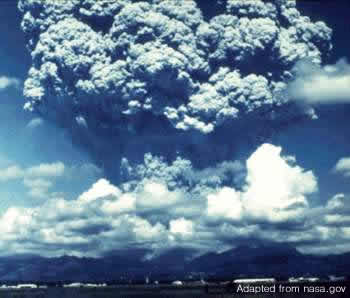Atmospheric Aerosol |
Home | <PREV | NEXT > |
:: Section 3
Natural Background Aerosol
The natural background aerosol can be divided into two categories: stratospheric aerosol and tropospheric aerosol.
A very important source of particulate in the stratosphere (altitude from 11 to 50 km) is the formation of sulfuric acid droplets by gas-to-particle conversion of SO2 injected into the stratosphere by major volcanic eruptions. These sulfuric acid droplets are the key condensation nuclei to form clouds in the atmosphere. Major volcanos can increase the stratospheric particulate concentration by two orders of magnitude. The Mount Pinatubo eruption in 1991 injected 14-20 Tg of SO2 into the stratosphere, causing the aerosol concentration to increase from 2-5 µg/m3 to 20-100 µg/m3.

Eruption of Mt. Pinatubo (in the Philippines) in 1991
The natural background aerosol in the troposphere (region below an altitude of 11 km) depends on direct emissions and gas-to-particle formation from natural sources, as shown in Table 1. On a mass basis, direct emissions from desert, the oceans, and vegetations are the largest sources of tropospheric aerosol. The concentration of tropospheric particles varies significantly with altitude. Above an altitude of a few kilometers, particle concentrations are influenced little by direct emissions from the earth's surface.
1. Why does tropospheric aerosol concentration vary significantly with altitude? |
|
| 2. What is the impact of increased stratospheric aerosol concentration on global climate? |